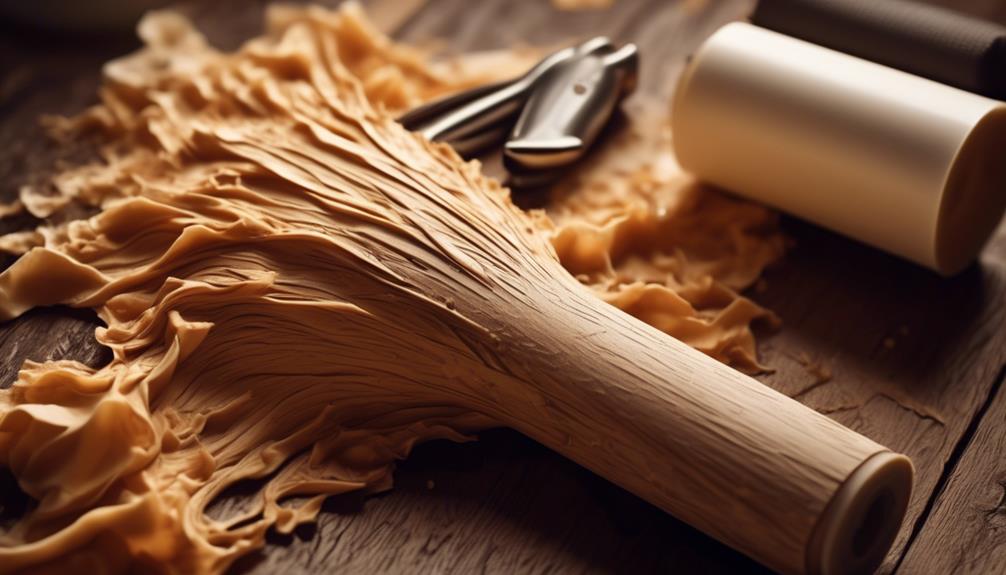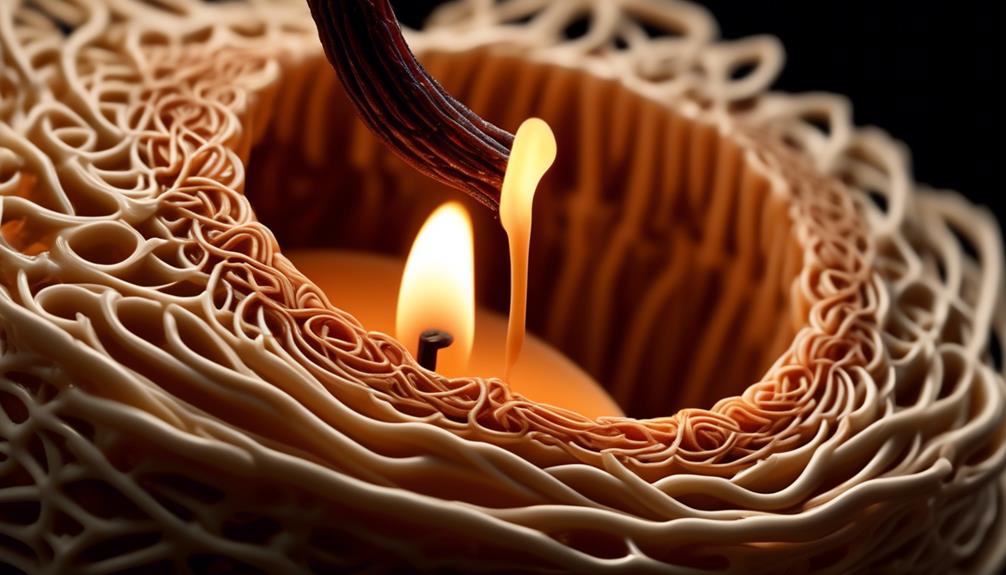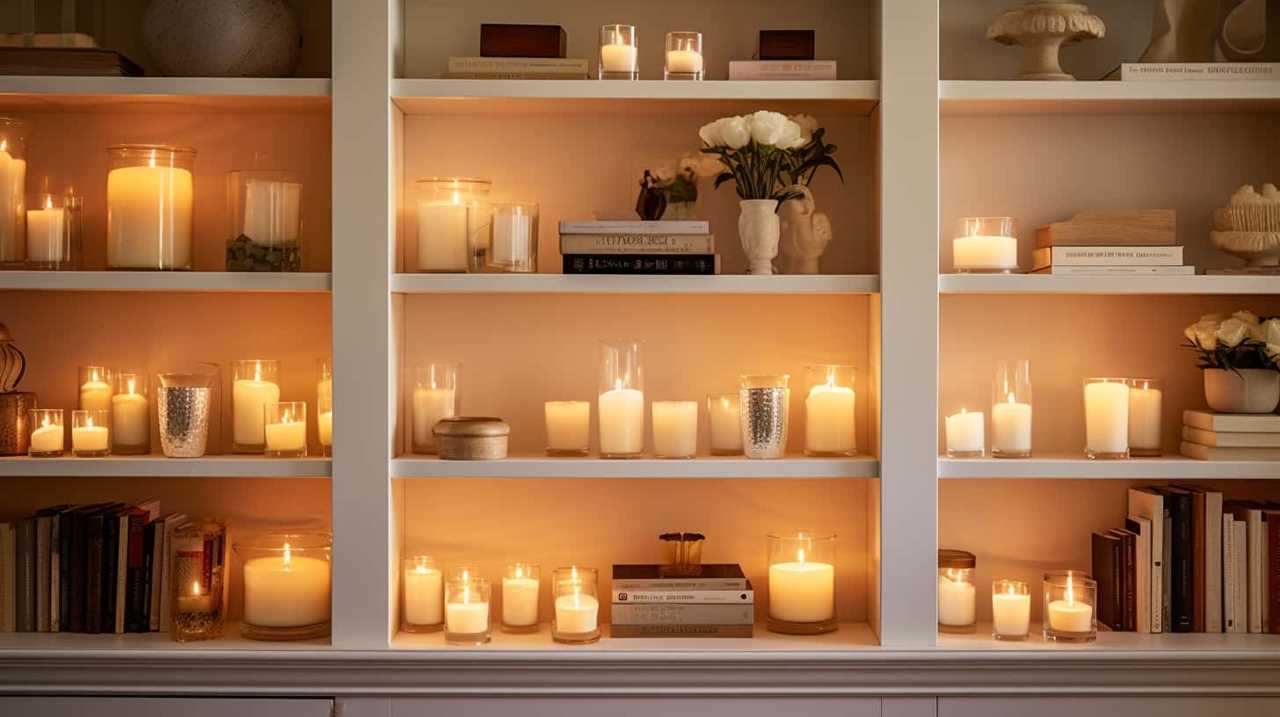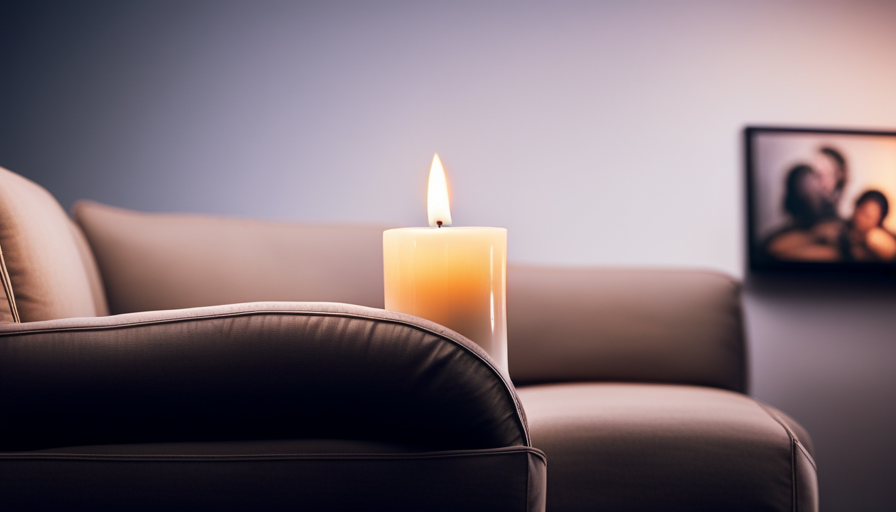Handling stubborn candle wax on wooden surfaces is akin to navigating a difficult situation that demands delicate care and expertise.
The process of removing wax from wood surfaces can be both challenging and rewarding, as it demands a delicate touch and the right tools to achieve a clean finish.
By exploring various techniques and products tailored for this task, we can uncover effective solutions that restore the natural beauty of wood.
Join us as we unravel the secrets to successfully eliminating candle wax from wood surfaces, ensuring a pristine outcome that will leave you pleasantly surprised.
Key Takeaways
- Use a plastic scraper to remove wax, scraping in the direction of the wood grain.
- Warm and soften the wax with a hairdryer or iron before removing.
- Consider using a specifically-made wax removal product for effective results.
- Clean and polish the wood surface after removing the wax for a finished look.
The Scraper Method
When tackling candle wax on wood, the Scraper Method offers a practical and effective approach for removal.
To remove wax from wood using this method, begin by arming yourself with a plastic scraper, such as a spatula, spoon, or even an expired credit card. Ensure you scrape the wax in the direction of the wood grain to prevent causing any damage to the wood surface.
Utilize the edges of the plastic scraper to dislodge wax from deeper crevices, ensuring a thorough removal process. As you chip away the wax, dust it into a piece of paper to keep the area clean.
Once you have successfully removed the wax, buff the wood surface with a lint-free cloth to restore its natural shine.
Keep in mind that the Scraper Method is best suited for lighter wax spills and demands patience and a delicate touch to avoid scratching the wood.
The Hair Dryer/Iron Method
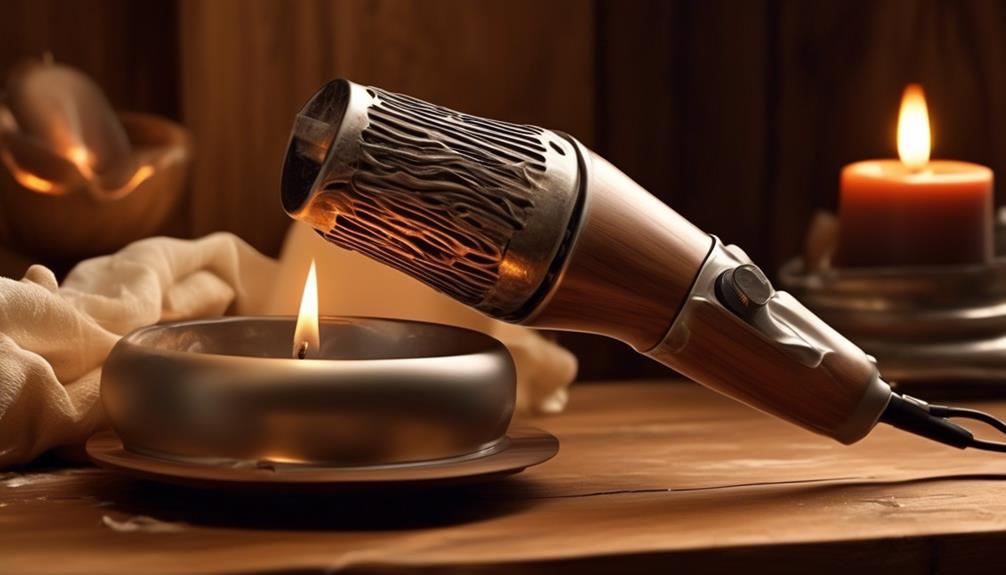
To effectively utilize the Hair Dryer/Iron Method for removing candle wax from wood, one can start by using a hair dryer on a low heat setting to warm and soften the wax. Gently peel off the softened wax with your fingers, being careful not to damage the wood.
Next, place a cloth or towel over the wax stain and use an iron on a low heat setting. The heat from the iron will transfer the wax onto the cloth, effectively removing it from the wood surface.
After transferring as much wax as possible onto the cloth, apply a commercial wax remover following the instructions provided. Wipe away any remaining softened wax.
In case there's still some residue left, gently sand the area with fine-grit sandpaper to ensure a smooth finish. Finish the process by buffing the wood with a clean cloth and applying a wood polish or wax for added shine and protection.
This method is efficient and can restore your wood surface to its former glory.
The Wax Removing Product Method
When it comes to the wax removing product method, we've got you covered with essential points to consider.
We'll guide you through the necessary steps for effective wax removal from wood surfaces.
It's crucial to choose the right product and apply it correctly for optimal results.
Wax Removal Steps
Regularly employing a specifically-made wax removal product such as Goo Gone or Weiman Wax ensures effective removal of candle wax from wood surfaces. When using these products, follow the instructions on the bottle for optimal results.
Here are four essential steps to guide you through the wax removal process:
- Apply the Wax Removal Product: Liberally apply the chosen wax removal product to the affected area.
- Let It Sit: Allow the product to sit on the wax for the recommended amount of time to penetrate and loosen it.
- Gently Wipe: Use a dry cloth to gently wipe away the softened wax, ensuring not to damage the wood surface.
- Repeat if Necessary: If any residue remains, repeat the process until the wood is free of candle wax.
Choosing Right Product
For effective removal of candle wax from wood surfaces, selecting a specifically-made wax removal product like Goo Gone or Weiman Wax is crucial. These products are designed to tackle wax stains on various wood surfaces, including wood floors, with ease. Here is a comparison table to help you choose the right stain remover for your needs:
| Product | Features |
|---|---|
| Goo Gone | – Powerful formula |
| – Easy application | |
| – Suitable for various wood types | |
| Weiman Wax | – Trusted brand |
| – Specifically formulated for wood | |
| – Quick and effective results |
When deciding on a stain remover, ensure it is easily accessible and follow the instructions carefully for optimal wax removal results.
Effective Application Techniques
Having selected the appropriate wax removal product for wood surfaces, our focus now shifts to mastering the effective application techniques to efficiently eliminate candle wax stains.
- Heat the Wax: Gently warm the wax with a hairdryer on a low heat setting to soften it for easier removal.
- Buff the Wood: Use a soft, lint-free cloth to gently buff the affected area after removing the wax to restore the wood's shine.
- Remove the Wax: Scrape off the softened wax using a plastic card or your fingernail, being careful not to damage the wood surface.
- Repeat if Necessary: If residue remains, repeat the heating and scraping process until the wood is clean.
Before You Begin
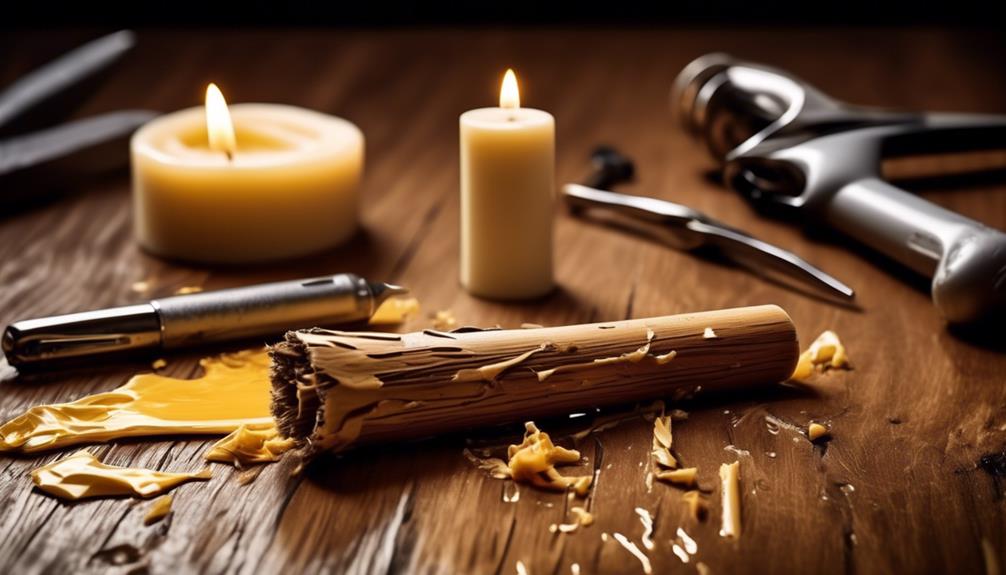
Before diving into the process of removing candle wax from wood, it's crucial to take the necessary steps to ensure a successful and damage-free outcome. Always start with gentle, basic steps before progressing to more aggressive methods.
Allow the wax to cool and harden naturally on the wood surface. An effective trick is to use an ice cube enclosed in a plastic bag to expedite this process. Patience is key; work slowly and meticulously to prevent any additional harm to the wood.
Once the wax has hardened, utilize a plastic scraper or even a credit card to gently lift the wax off the surface. Avoid using metal tools that could scratch or gouge the wood.
Additionally, consider using a steam setting on a clean cloth to help soften the wax for easier removal.
Scrape Away Gently
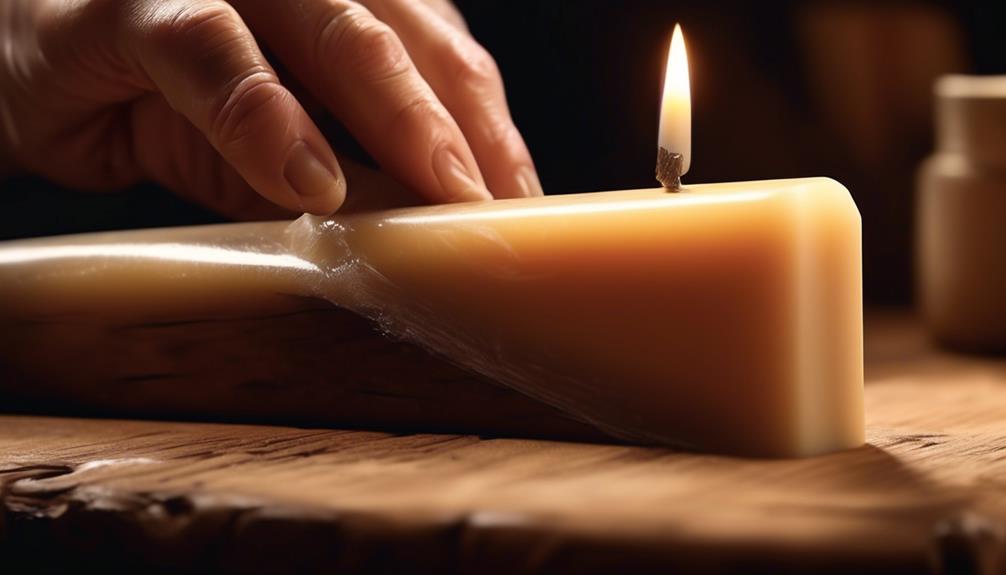
When scraping away candle wax from wood, it's essential to handle the process gently to avoid damaging the surface. Using a plastic spatula or an expired credit card can help dislodge the wax without causing scratches.
Carefully following the wood grain and being patient during the scraping process ensures a successful removal without harming the wood.
Use Heat Method
To effectively remove candle wax from wood using the heat method, start by using a hairdryer on a low heat setting to soften the wax before gently scraping it away. Here are four steps to master this technique:
- Apply Heat: Direct a hairdryer's low heat onto the wax to soften it for easier removal.
- Iron Transfer: Place a brown paper bag or parchment paper over the wax and iron it to transfer the wax onto the paper.
- Commercial Wax Remover: Follow the manufacturer's instructions when using a commercial wax remover for stubborn wax stains.
- Fine Sanding: Use fine-grit sandpaper to gently eliminate any remaining wax residue on the wood surface.
Apply Cleaning Solution
How effectively can a cleaning solution like vinegar and water help in gently scraping away candle wax from wood surfaces without causing damage?
When tackling the task to remove candle wax from wood, applying a cleaning solution is a crucial step in the process. The vinegar and water solution aids in breaking down the wax, making it easier to scrape away.
By saturating a cloth with the solution and gently dabbing at the wax stain, the wax begins to soften, allowing for gentle removal without harming the wood.
Utilizing a plastic scraper or an expired credit card, carefully scrape away the softened wax, ensuring not to scratch the wood surface.
Wipe off any remaining residue with a clean cloth, repeating the process if necessary until the wood is wax-free.
Remove the Loose Wax

Carefully scrape off the loose wax from the wood using a plastic spatula, spoon, or expired credit card, ensuring to follow the direction of the wood grain for best results.
Here's how to effectively remove the loose wax:
- Utilize the Proper Tools: Opt for a plastic spatula, spoon, or an expired credit card to gently lift the wax from the wood surface without causing damage.
- Work Along the Grain: Moving in the direction of the wood grain helps prevent any additional scratches and ensures a smoother removal process.
- Target Deeper Crevices: Use the edges of the scraping tool to dislodge wax that may be stuck in crevices, being careful not to dig too forcefully into the wood.
- Collect Residue Carefully: As you chip away the wax, dust the collected residue onto a piece of paper to keep your work area clean and make the removal process more manageable.
Clean and Polish the Wood Surface
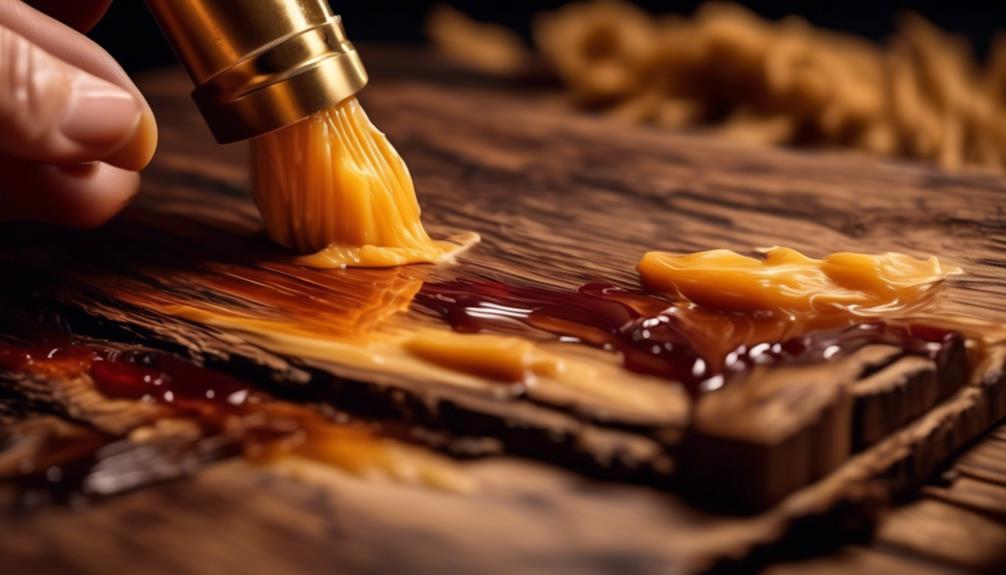
When cleaning and polishing the wood surface, remember to select a gentle wood cleaner suitable for the type of wood you're working with. It's essential to choose a cleaner that will effectively remove any residual candle wax while being gentle enough not to damage the wood surface.
Begin by applying the wood cleaner to a clean cloth or sponge, ensuring it's damp but not dripping. Gently wipe the wood surface in the direction of the grain to avoid causing any scratches.
After removing the candle wax, thoroughly clean the wood surface to eliminate any remaining cleaner residue. Once the surface is clean and dry, you can proceed to polish the wood to restore its natural shine. Select a high-quality wood polish that's compatible with your specific type of wood to achieve the best results.
Apply the polish in a thin, even layer, following the wood grain for a smooth and lustrous finish.
Regularly cleaning and polishing your wood surfaces won't only remove candle wax effectively but also help maintain their beauty and durability over time.
Using Heat to Remove Tough Wax Stains
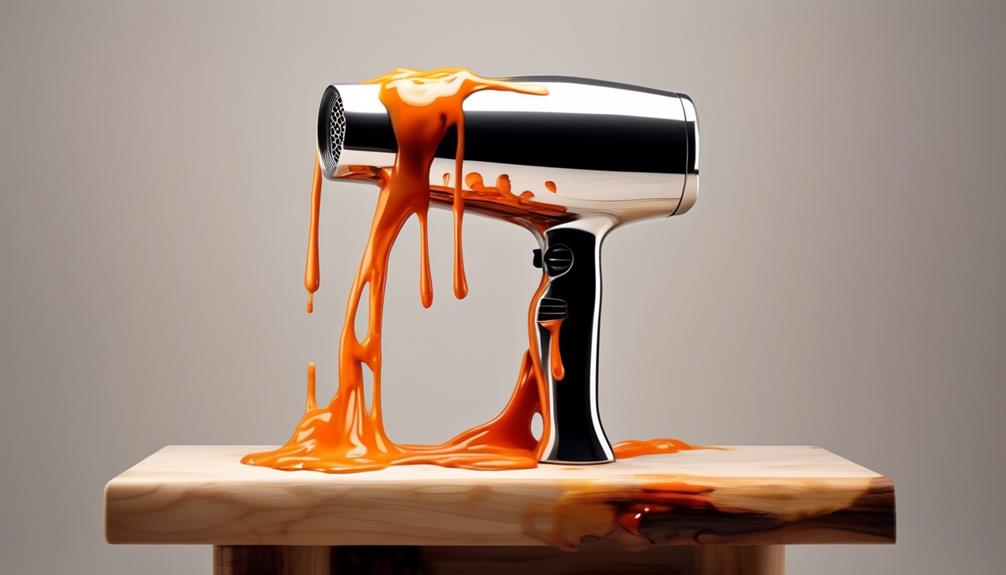
To effectively tackle tough wax stains on wood surfaces, consider using a hairdryer on a low heat setting to soften the wax before proceeding with removal techniques. Here are some steps to guide you through using heat to remove stubborn wax stains from wood:
- Apply Heat: Direct the hairdryer on a low heat setting towards the wax stain. Move the hairdryer back and forth over the wax to soften it without causing damage to the wood.
- Scrape Off the Wax: Once the wax is softened, gently scrape it off using a plastic card or a putty knife. Be careful not to scratch the wood surface while removing the wax.
- Transfer Remaining Wax: Place a brown paper bag or parchment paper over the softened wax and iron over it. The heat will help transfer the remaining wax onto the paper, away from the wood.
- Finish with Wax Remover: If there's still residue left, apply a commercial wax remover following the manufacturer's instructions to completely remove any stubborn traces of wax.
Select the Iron Temperature
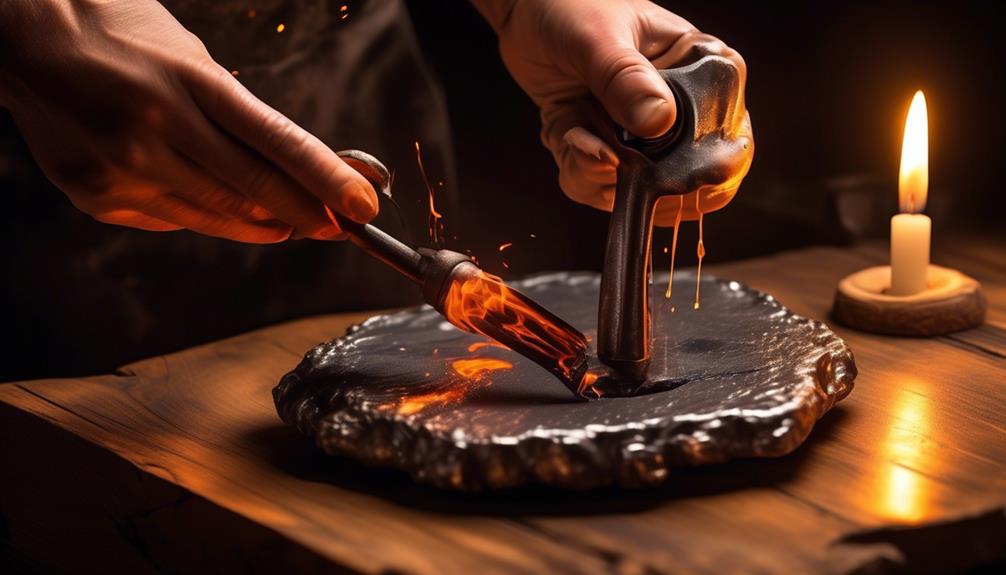
After using heat to soften tough wax stains on wood, the next crucial step is selecting the appropriate iron temperature to ensure safe and effective wax removal without causing damage to the wood surface.
Begin by setting the iron to the lowest temperature to prevent wood damage. It's essential to increase the temperature gradually if necessary, but be cautious not to overheat the iron, as this can lead to burns or discoloration on the wood.
Test the iron temperature on a small, inconspicuous area of the wood before applying it to the wax stain to guarantee it won't harm the surface. If the temperature is too high, the wax might melt too quickly and spread, complicating the removal process.
To safeguard the wood from direct heat, place a heat-resistant cloth or towel between the iron and the surface.
Cover the Wax Stain
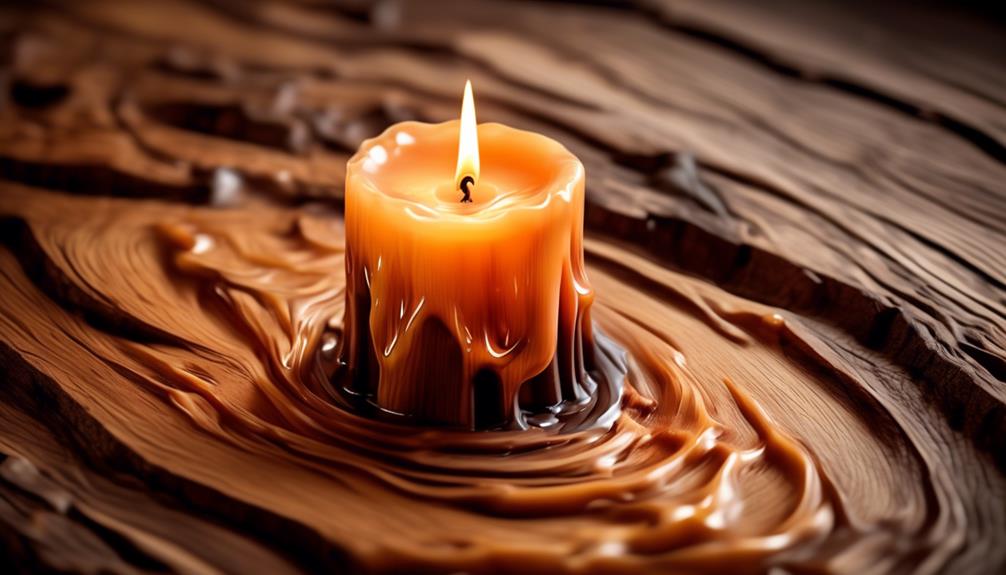
To effectively cover the wax stain on wood, we recommend using a protective covering such as a paper towel or a cloth to prevent direct contact with the surface.
Once covered, apply a heat source like a hairdryer or an iron on a low setting to gently warm the wax, making it easier to remove without damaging the wood.
This method helps contain the wax and facilitates its removal, ensuring a cleaner finish on your wooden surface.
Use Protective Covering
How can we effectively cover the wax stain on the wood to begin the removal process? To ensure the successful removal of candle wax from wood, we must use a protective covering. Here's how to do it:
- Select a Protective Covering: Choose a brown paper bag or parchment paper to cover the wax stain on the wood.
- Apply Heat: Use a hairdryer or an iron on a low heat setting to apply heat to the covered wax stain.
- Melting Process: The heat will cause the wax to melt and transfer onto the paper covering.
- Remove and Discard: Gently lift the paper covering and discard it along with the melted wax, ensuring the wood surface is clean.
Apply Heat Source
Covering the wax stain with a brown paper bag or parchment paper provides a protective barrier as we apply heat to soften and remove the wax from the wood surface.
To effectively remove candle wax from wood, place a cloth over the paper and run a warm iron over it. The heat will cause the wax to melt and transfer onto the paper, away from the wood. Be cautious not to set the iron too hot to avoid damaging the wood.
This method helps lift the wax stain from the wood grain, making it easier to eliminate. Once the wax has transferred to the paper, continue the process until the wood appears clean.
Heat and Absorb the Wax
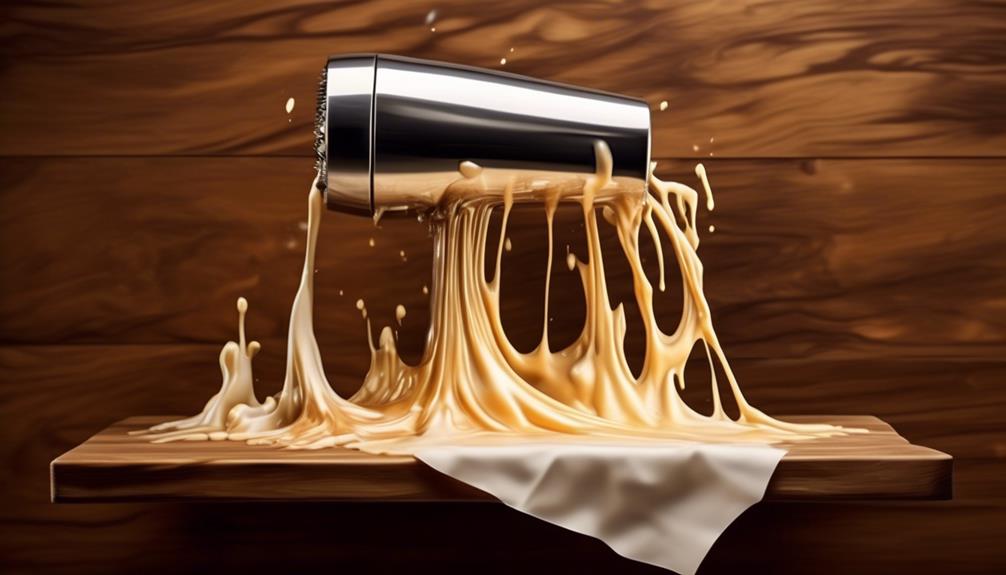
When removing candle wax from wood, one effective method is to heat and absorb the wax using a hairdryer on a low heat setting. Here's how to effectively execute this method:
- Apply Heat with a Hairdryer: Direct the hairdryer on a low heat setting towards the wax spot to soften it, making it easier to remove.
- Absorb the Wax: Place a soft cloth over the softened wax and gently press down to absorb the melted wax. Repeat this process with a clean section of the cloth until no more wax transfers.
- Use a Plastic Bag: For stubborn wax spots, cover the softened wax with a plastic bag and gently rub over it with your fingers. The plastic bag helps to lift the wax off the wood surface.
- Final Cleaning: Once the majority of the wax is removed, use a commercial wax remover as per the manufacturer's instructions to ensure all traces are gone.
Polish and Buff the Wood Surface
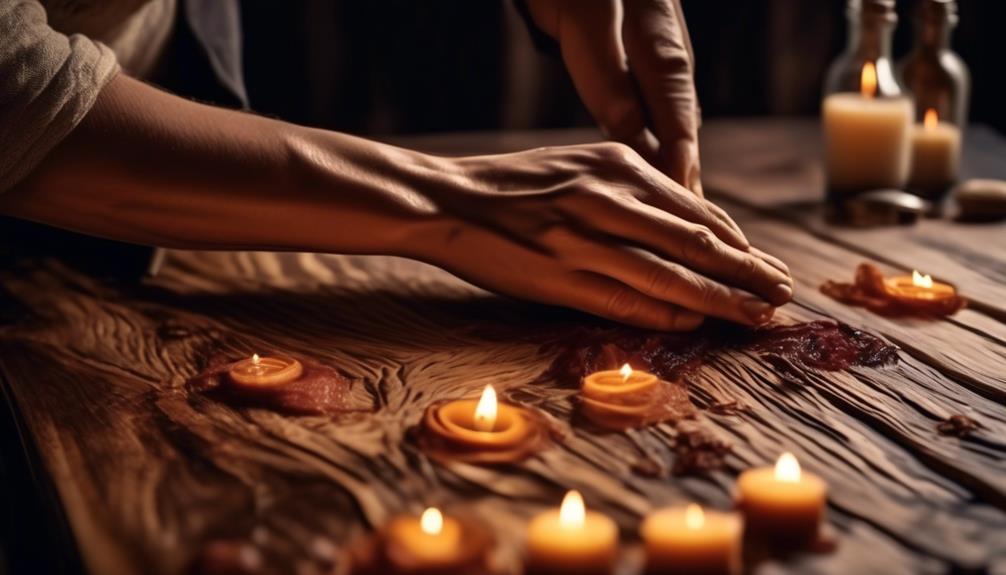
After successfully removing the wax using the hairdryer method, the next step is to polish and buff the wood surface to enhance its appearance and restore its natural shine.
To begin, take a soft cloth and apply a small amount of furniture polish to it. Gently rub the cloth in circular motions over the wood surface. This process will help to remove any remaining residue and bring out the wood's luster.
Ensure that the cloth is soft to prevent any scratches on the wood. Avoid using excessive force while buffing to maintain the wood's integrity. The gentle pressure will allow the polish to penetrate the wood and bring out its natural beauty.
Once you have completed the buffing process, take a clean cloth to wipe off any excess polish. This final step will give the wood surface a smooth and glossy finish.
Admire the restored shine of your wood furniture, knowing that you have successfully removed the candle wax and rejuvenated its appearance.
Wax Removal From Rough, Unfinished Wood

When dealing with wax on rough, unfinished wood, our go-to method involves utilizing sanding techniques and applying heat.
Sanding rough surfaces aids in removing wax residue from the wood's crevices effectively.
The application of heat, whether through an iron or hairdryer, helps to melt the wax for easier removal without damaging the wood.
Sanding Rough Surfaces
To effectively remove wax from rough, unfinished wood surfaces, consider utilizing a fine-grit sandpaper to gently sand away any remaining residue. Here are some steps to guide you through the process:
- Begin by sanding the affected area in the direction of the wood grain to avoid causing any damage.
- Use light pressure and check your progress frequently to avoid over-sanding the wood.
After sanding, wipe the surface with a soft cloth to remove any sanding dust and residual wax particles.
- Repeat the process if necessary until the wood surface is smooth and free of wax buildup.
With patience and attention to detail, sanding can effectively restore the natural beauty of your unfinished wood while removing candle wax remnants.
Using Heat Method
Using the heat method for removing wax from rough, unfinished wood involves several steps.
First, harden the wax by placing ice cubes inside a plastic bag and applying it to the wax. Allow the wax to become hard.
Next, gently scrape off the surface wax with a plastic scraper. Make sure the plastic edge remains flat against the wood surface to avoid damage.
To remove any remaining wax residue, sprinkle talcum powder on the affected area.
Place a soft cloth over the powder to protect the wood and apply medium heat using an iron or hairdryer.
The heat will help lift the wax from the wood, while the talcum powder aids in absorbing any excess wax.
This step-by-step process ensures a thorough removal of wax from rough, unfinished wood.
Harden the Wax
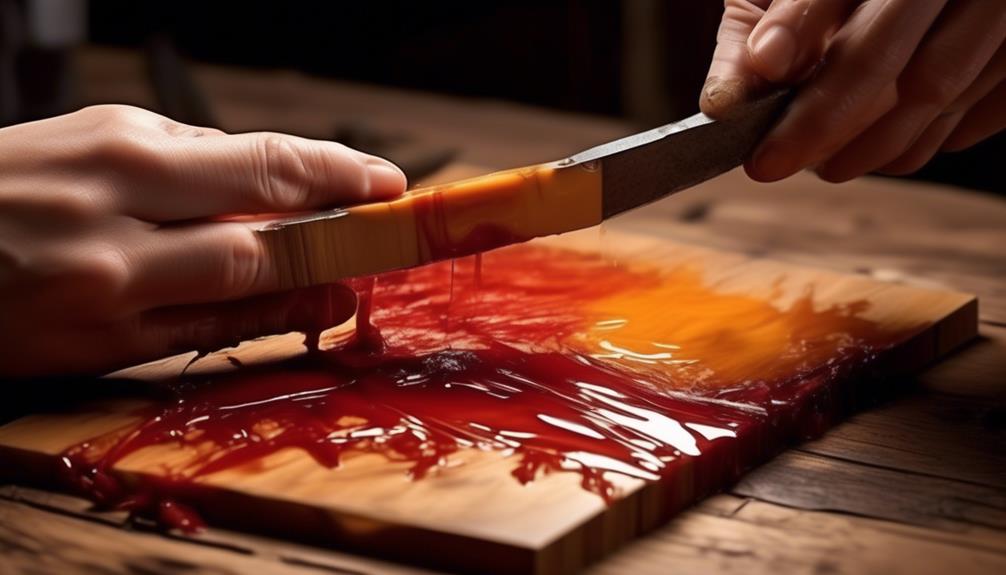
Placing ice cubes on top of the wax for a few minutes will effectively harden it for easier removal from the wood surface. This method causes the wax to solidify, making it less pliable and simpler to lift off the wood without causing damage.
After the wax has hardened, follow these steps:
- Scrape Gently: Use a plastic scraper or card to gently scrape off the now hardened wax. Be cautious not to apply too much pressure to avoid scratching the wood surface.
- Clean Residue: If there's any residue left behind, create a mixture of distilled vinegar and water. Dab an old cloth into the mixture and gently clean the area to remove any remaining wax.
- Buff with Soft Cloth: Once the wax is removed, buff the wood surface with a soft cloth to restore its shine and smoothness.
- Apply Olive Oil: For a final touch, apply a small amount of olive oil to the wood surface and buff it in to achieve a glossy finish.
Frequently Asked Questions
How Do You Get Candle Wax off Wood?
We've encountered that challenge before.
Removing candle wax from wood involves some careful steps. Scraping the wax in the direction of the grain can work, followed by a gentle buff with a lint-free cloth.
Using heat from a hair dryer or iron to warm and soften the wax is another effective method.
Specialized wax removal products like Goo Gone or Weiman Wax can also do the trick if used according to instructions.
What Removes Dried Candle Wax?
We've got the perfect solution for you!
To tackle dried candle wax, try using a combination of gentle scraping with a plastic spatula and melting with a hairdryer or iron. Once the wax is softened, wipe it away with a cloth.
For stubborn residue, a commercial wax remover like Goo Gone works wonders.
Finish off by cleaning the area with a vinegar solution and buffing with olive oil for a polished look.
Does Vinegar Remove Wax From Wood?
Yes, vinegar can effectively remove wax from wood surfaces. When mixed with water in equal parts, the vinegar creates a potent cleaning solution.
By dipping a soft cloth or sponge into this mixture and gently scrubbing the waxed area in circular motions, the wax can be loosened. Wipe away the residue with a clean cloth, repeating the process if necessary.
Vinegar's acidic properties make it a great natural solution for removing wax from wood.
How Do You Remove Wax From Wood Without Sanding It?
We've faced this challenge before—removing wax from wood without sanding. Our go-to methods involve gentle scraping, applying heat to soften the wax, or using specialized wax removal products.
The Scraper Method delicately lifts the wax, while the Hair Dryer/Iron Method warms and peels it away. For stubborn wax, the Wax Removing Product Method comes to the rescue.
Conclusion
In conclusion, removing candle wax from wood is a simple task that can be easily accomplished with the right tools and techniques. By following the steps outlined above, you can effectively eliminate any wax spills and restore the beauty of your wooden surfaces.
Remember to act quickly, be gentle yet thorough in your approach, and always finish off with a touch of polish for that extra shine. With these methods, your wood will be looking as good as new in no time!
